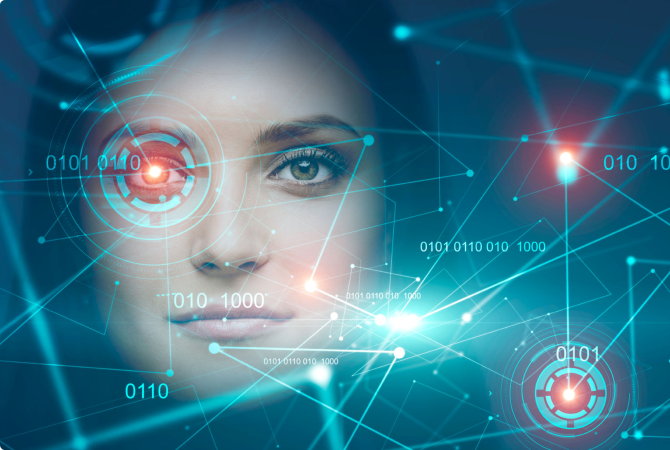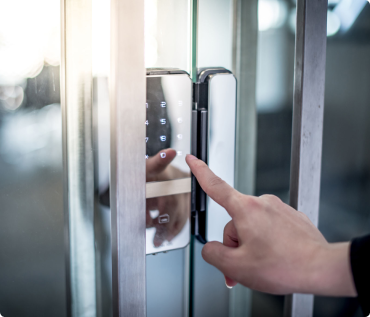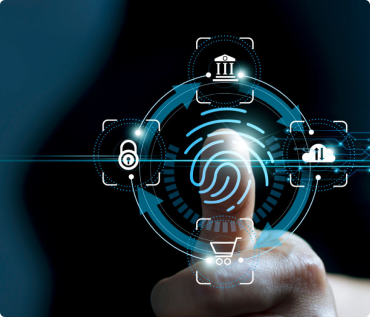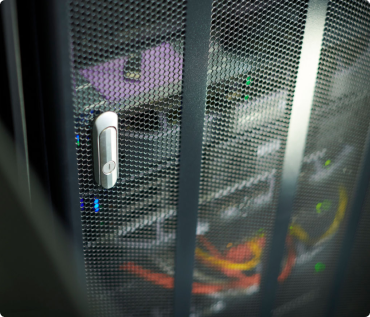The use of the biometric system for the purpose of security and authentication has rapidly increased over the past few years around the world. It has become a part of the daily life of most people. The integration of biometric technology is not only limited to the official setup but plays a major role in mobile technology on a daily basis. The latest trends in biometric authentication are observed in banking services, medicine, marketing, and various other areas that require personal identification and authentication.
What are Biometric Systems?
Biometrics is a method of assessing the physical characteristics to authenticate a person’s identity that involves various choices like voice recognition, face recognition, retina or iris scan, fingerprints scan, vein infrared thermogram, or a combination of the mentioned identifiers.
Security biometric authentication is one of the most robust security solutions for businesses. With the increase in the number of security frauds, many institutions are forced to carry out strict security measures. Hence, biometric systems provide a feasible alternative to traditional systems.
Existing Biometric Technologies
The existing biometric technologies are the ones that we might use daily while others are not very common.
1. Fingerprint Recognition: Fingerprint verification uses an individual’s unique fingerprint to authenticate their identity.
2. Face Recognition: Facial recognition systems use an individual’s unique facial framework to recognize them.
3. Retina/Iris Recognition: Retina or iris recognition uses the exclusive pattern of iris or retina of an individual to recognize them. It is one of the most precise biometric authentications accessible.
4. Voice Biometry: Voice biometry or voice recognition uses the exclusive tone, pitch, and frequencies of an individual’s voice to verify their identity.
5. Gait Recognition: Gait identification uses the way someone walks to recognize them.
6. Vein Recognition: Vein recognition uses the exceptional pattern of blood vessels in an individual’s hand or their finger to recognize them.
What is the Future of Biometric System?
The biometric systems are still undergoing development and testing. Nevertheless, the biometric system will take over and will be used in almost all the settings. The traditional cards or keys will disappear shortly and biometric authentication will become the common daily operation.
The most obvious issue with the biometric system is its promotion. People are aware that you have various body parts, eyes, face, and fingers. However, this is just a small part of biometric authentication that is seen or known but there is a much larger part that is not seen or known about. There are rigorous experiments that are taking place to assess every probable trait, from examining the heartbeat to planting chips under the skin, scanning intraocular vessels, the shape of your earlobes, and so much more. The forthcoming biometric system remains in its easiness. A high level of security can be gained by modifying modern methods.
Biometric authentication systems are rapidly developing and it is quite challenging to foresee what they might look like in the upcoming years. Regardless, the biometric systems will replace the use of passwords and other security measures that are difficult to change, utilize and remember.
Secure Data Storage
The usage of biometric systems pertains to the identification and authentication of an individual for the overall security of the business. However, it is not the only available technology in the market. There is a wide range of technologies that can be used like passwords, PINs, and other documents.
There is not even a single technology that provides a cent percent security against the threats posed. The same is applicable to biometric systems. Still, a biometric system can help businesses to enhance the security of confidential data. A multi-factor biometric authentication system is an effective solution to avoid any kind of unauthorized access to confidential data.
Applications in Business
The business application of biometric systems is widespread. Below are the following areas that use biometric authentication for the purpose of security:
1. Mobile payment: In the advanced method of payment that is mobile payment, biometric authentication plays a vital role. Nowadays, mobile payments are comparatively more secure than card payments as they involve a biometric system to validate the identity of the user.
Looking at the statistical data, a huge number of smartphones and tablets with a built-in fingerprint reader have been distributed worldwide. This will continue to increase with time as these devices have become an integral part of every individual.
2. Online Banking: In global internet banking is one of the most vulnerable markets to security and data breaches. Therefore, to overcome this problem biometric authentication has proven to be a good measure of security. The most popular type of biometric authentication was fingerprints. Regardless of their unique characteristics, they have their own limitations.
3. Immigration Services: The leading technological innovation in immigration or customs at airports and various other checkpoints around the world is biometric authentication. The most commonly used methods are the use of fingerprints and face recognition for the boarding of passengers and check-in of luggage. Biometric passports are well-known. Along with biometric kiosks, biometric passports provide a reliable authentication tool for an individual travelling from and to various countries.
4. Covering Government Needs: The use of the biometric system is gradually increasing for border control and counter-terrorism. Most often it is used by government agencies to verify the identity of the person with accurate results.
The biometric system is also used to attain forensic goals. They are beneficial as they enable you to recognize a person and corroborate if they were a part of a specific crime. The events, places, actions, and other things can be connected to a particular person to unravel their association with an individual.
5. Staff Management: The biometric authentication aids the human resources department to offer precise attendance information, eliminates labour costs and redundant payroll costs. Additionally, it also minimizes operating costs by removing the need for an ID card or keys. The biometric system helps to enhance employees’ accountability and can lead to an absolute improvement in productivity.
6. Health Care and Social Assistance: Health care organizations are slowly shifting towards the use of biometric systems. Biometric authentication of staff and patients improves the treatment process and almost reduces the probability of errors. The usage of a biometric system for opening medical files and reports is dependable as it secures the information including the patient’s records.
At the same time, it saves a lot of time for staff to focus on constructive work rather than entering login details every time they access the files. The biometric system safeguards the institution and tracks the movement of staff, patients, and visitors in the facility of the healthcare organization.
Multi-Factor Authentication
The use of multi-factor authentication uses a combination of security solutions to strengthen the safety of any organization. It uses tokens, passwords, PINs, smart cards, and biometric authentication to minimize the chances of threats to security. It is one of the most efficient techniques to secure the organization from any unauthorized access.
How Biometric Systems are Shaping the Future?
The use of biometric systems has become common. Therefore, various trends can be observed in the future.
1. Authentication Tools: The biometric system is majorly used as an authentication tool. The latest trend that is observed is the use of multi-modality biometric authentication, where there is a use of multiple biometric technologies together.
A biometric access token is an authentication tool for personal devices. Modern technologies like smartphones have integrated cameras and microphones along with biometric authentication like face recognition or fingerprint scan.
2. Biometric Single Sign-On Services: The biometric single sign-on technology offers the capacity to utilize a single identifier to retrieve all the authorized IT resources and systems. The users are required to only give authentication data to enter the application. This can involve methods like going to face recognition, or say a phrase loudly for voice recognition, or scanning their fingerprints using a scanner.
3. Facial and Voice Recognition: Face and voice recognition are evolving quickly. The most common trend for 2021 has been the use of smartphone authentication and identity definitions in crowded areas. The modern trend is the use of voice recognition that is introduced in voice control technology into cars. These devices centrally regulate the functions of the cars with the help of human voices. Thus, eradicating the need for switches, buttons, or dials.
With the help of voice recognition devices, an individual is better able to easily manage the variety of vehicle functionalities. Thus, allowing the person to be comfortable and easily focus on driving without any distraction.
4. Mobile Biometric Technologies: The advanced trends in the biometric system are concentrated to a substantial fall in mobile biometric technologies and improve ease of use. The use of mobile biometric technologies is highly dependent on the active use of smartphones with integrated sensors.
5. Cloud-Based Biometric Solutions: The development of biometric authentication corresponds to the development of cloud solutions. The latest technological solutions’ objective is to combine different parts into multifaceted solutions that fulfil the need of the customers. Therefore, the integration of cloud-based solutions and biometric systems as a segment of multi-factor authentication devices is the upcoming future of biometrics.
Conclusion
All the changes that are introduced require some time for people to adjust to it. The world today is highly dominated by technology. Biometric systems are the latest and developing technologies for biometric authentication to provide security to organizations. The benefits of biometric authentication surpass any potential negatives. The future is still unclear but it can be assumed that biometrics is going to be an integral part of every individual on a day-to-day basis.





